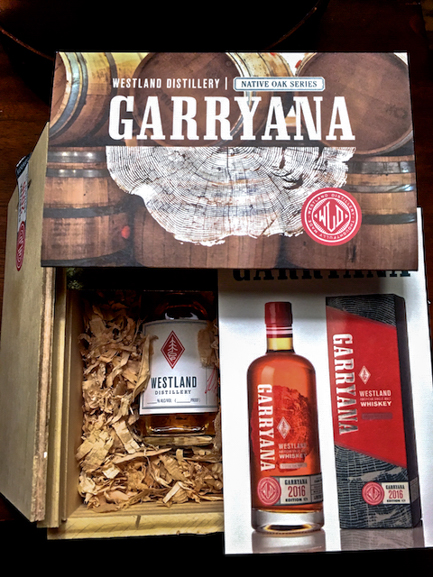Westland's Garryana: A Preview

I've said it before and I'll say it again: I'm a big fan of Seattle's Westland distillery. If pressed, I might go so far as to say it's the best whiskey distillery of any kind in the United States. Few whiskey producers possess the entire package, from branding to personnel to quality to drinkability, but there are a number of reasons beyond the obvious that endear me to Westland; characteristics that contribute to the growth of the entire industry not just the company itself. Number one: Westland is urban and accessible. You can visit Seattle and the distillery without having to drive two hours out of the way. Number two: it's run by a group of kids all under the age of forty (many under the age of thirty) who have a better idea of the modern palate and a modern style. Number three: they realized early on that making good whiskey involved both heavy investment and creative innovation. These guys not only put together one of the most incredible distilleries I've ever visited, they also invested in their own local peat bogs and their own local source of oak, and I must point this out here: Westland didn't go local because it was cool, trendy, or à la mode. They went local because they're in this game for the long haul, which was clear in the way they approached each facet of their business right from the start. In the modern spirits era where more than half of new distilleries are speculative investments, these kids wanted to build a dynasty. They wanted to create the next great Pacific Northwest company, which was apparent in their admiration for other local enterprises like Filson. I love everything they're doing and I think they're a model for other budding American distillers.
Now that I've got all my gushing out of the way, let's talk about Garryana—an upcoming limited release of 2500 bottles from Westland that uses Quercus Garryana white oak to mature the whiskey. Garryana is a species native to the Pacific Northwest, hence Westland's branding of the whiskey as part of its "native oak series." Let me add some perspective here again: I've tasted dozens of spirits over the last few months that stress locality—local botanicals, local water, local native yeasts, local barley, local fruit, and even other examples of locally-coopered oak barrels. Few of them tasted unique. Even fewer of them tasted good. It's important for me to make that clear because my fear is that Garryana is going to get bogged down in the saturated sea of similarly-marketed spirits when it's clearly the cream of the crop. When you smell the new Westland Garryana, you instantly inhale something special. When you taste the new Westland Garryana, you draw back quickly from the intensity. There's a roasted, seasoned flavor on entry. It's oak, but it's not your standard American oak profile. It's exotic and alive, brimming with spiced vanilla and toasted goodness. What's even more interesting is that only 21% of the blend was aged in Garryana oak. The other 79% was aged in standard Quercus Alba oak, leading me to take distiller and blender Matt Hofmann seriously when he says "Garryana is not Quercus Alba, nor does it behave like it, as we've quickly discovered." Not unlike the famous Japanese mizunara oak that imparts an intense profile of sandlewood and coconut, and therefore must be used with restraint, I get the feeling that Garryana oak must handled with care.
The recipe for the Garryana blend is as follows:
21% pale malt aged in new Garryana oak
26% peated malt aged in new Alba oak
10% pale malt aged in used Alba oak
43% five malt aged in new Alba oak
It's bottled at 56.2% cask strength and it is insanely delicious. Regardless of whether you care about Westland's philosophy, its homegrown story, its sense of style, the sleek and modern design, or the intensity of flavor imparted by a species of oak native to the Pacific Northwest, I'd still advise any and every whiskey fan to grab a bottle of the Garryana simply because it's wonderful. It's a symphony of malt, vanilla, oak, and spice—four classic components of any great dram—that succeeds simply because it's well made. There's nothing gimmicky or contrived about the flavors. It's not some weird, science project whiskey that you'll only drink every once and a while when you're in the mood. It's a great bottle of booze, pure and simple—the kind of thing you'll have to force yourself to stop drinking when you're seriously jonesing for seconds and thirds. The finish, however, is where you really comprehend the power of the Garryana oak. I've been sipping on my mini sample bottle while typing this post and all I can taste in my mouth right now is that roasted, dusty, and sweetly-scented oak profile mingling ever so happily with the subtle peat smoke. The whiskey is as much of a testament to Matt's clever blending as it is to the oak. The shape of the whisky is remarkable—the way the sweetness tickles the tip of your tongue on the entry before moving through to the spice and power of the oak. I'm thrilled.
I don't know how much we're getting, how much it will cost exactly, or when we'll be getting our allocation, but I'm buying a bottle as soon as this whisky arrives. I can't promise anyone they'll love it as much as I do, but I can promise one thing for sure: you're not paying for bullshit.
-David Driscoll
